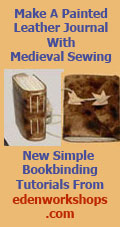Gilding Onto Leather
There are many different types of leather, from the soft, flexible vegetable tanned leathers used in bookbinding, to hard chromium tanned leathers used in briefcases and saddlery.
With regard to bookbinding, in general the gilded decoration you see on a modern book will be either gold foil or gold leaf, genuine gold leaf is reserved for the real quality leather bindings, and gold foil for cheaper work.
For those whose interest lies in bookbinding there is a fully illustrated step by step method showing the gilding process in full.
Both methods of gilding onto leather involve the use of heat activated adhesives, gold foil has a built in layer of adhesive on the carrier film.
In traditional gilding on leather, the heat activated adhesive takes the form of either the whites of eggs or a shellac based adhesive.
First the adhesive is applied and allowed to dry, then the leaf is laid over it. Heated brass tools in the form of lettering or decoration are then pressed down onto the gold foil or gold leaf. When the surplus gold leaf or gold foil film is removed the letters or decoration are left in gilt.
If there is a secret to success with gilding on leather it lies in understanding and working with the 3 variables involved, they are; Heat, Pressure & Dwell.
The heat of your tools is fairly critical for success, also how much pressure you apply and how long you stay in contact with the work are important and can best be learned by good instruction and a little trial and error.
With other leathers such as the type of sheepskin you might encounter when recovering desk tops, I suggest either using gold foil for cheaper work and 23 carat gold leaf on a paper carrier for best work.
Saddlery leather or briefcase leather is best treated with a shellac/spirit based glaire (adhesive.)
Some materials are called leather just because they are made from reconstituted leather shavings held together with a form of resin, I suggest using gold foil for this type of material.
As you have seen, when gilding on leather different methods need to be applied according to the leather.
Generations of bookbinders have made their own parchment papers and imitation vellums, we show you how.
EVERY MONTH I SEND OUT A NEWSLETTER WHICH AIMS TO BRING YOU INTERESTING ITEMS CONCERNING THE WORLD OF GILDING AND RELATED CRAFTS. IF YOU WOULD CARE TO SUBSCRIBE PLEASE JUST MAIL Richard at [email protected] and put "gold-vault" in the subject box. |
 Gilding onto
leather is different from gilding on wood or
other surfaces.
Gilding onto
leather is different from gilding on wood or
other surfaces. You can of course use imitation
gold leaf when gilding leather, it has the
advantage of being very cheap and is good to practice
with, though the work has to be sealed with lacquer after
gilding.
You can of course use imitation
gold leaf when gilding leather, it has the
advantage of being very cheap and is good to practice
with, though the work has to be sealed with lacquer after
gilding.